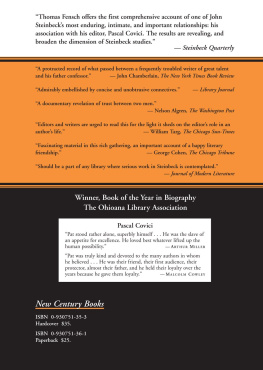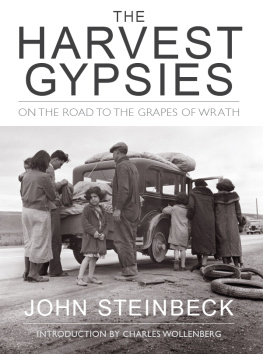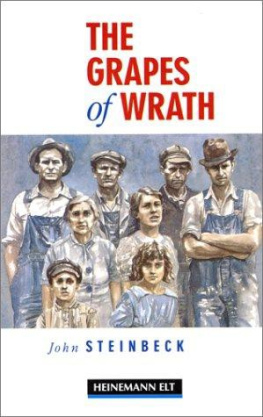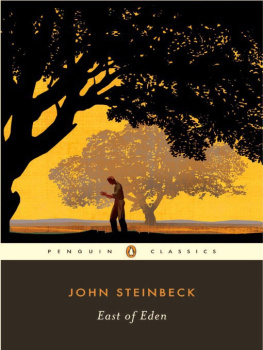ACKNOWLEDGMENTS
WHEN I WAS A teenager, my parents bookshelves yielded both The Grapes of Wrath and The Moon Is Down. More recently, those same shelves provided me with a copy of Steinbecks Nobel Prize acceptance speech. My thanks, then, to my parents for introducing me to the works of John Steinbeck.
Steve Planson of Greensboro presented me with an important Steinbeck reference early in my preparations for this biography. My dear friend Joyce Earnhardt, to whom this book is dedicated, delivered other materials as the book was taking shape.
Ed Ferrell, Henry Morrison, and Joan Gurgold all contributed to this book.
My friend and editor Linda Cabasin has proved with each biography in this series the value of good editing. This time she helped even more in sorting out the complexities of material and interpretation that accompany any literary biography. She is an exceptional person.
And always my wife, Martha, and our son, Alec, kept me conscious of my responsibilities to readers and to John Steinbeck.
ONE SALINAS BOY
THE REGION INTO WHICH John Steinbeck was born in 1902 offered all the diversity of terrain anyone could imagine. Californias long Salinas Valley held more than 600,000 of Americas most fertile acres. Through the center of the valley, flanked by stands of willow and cottonwood, flowed the Salinas River. Mountains surrounded the valley. To the east stood the gentle Gabilan Range, its Spanish name taken from the hawks that soared in the high sky. To the west climbed the Santa Lucia Mountains, rugged peaks, some of which reached up a mile and more. Beyond the Santa Lucias the land sloped steeply down to meet the Pacific Ocean.
Valley, mountains, shore, seaSteinbeck could have spent his life within fifty miles of his birthplace and never have exhausted the variety of vistas. In a way he never did exhaust those vistas, for he returned to them both physically and in his writings throughout his life.
Steinbecks grandparents had come to this peaceful valley across arduous routes. His paternal grandfather, Johannes Adolph Grossteinbeck (sometimes spelled Grosssteinbeck) left his home near Dortmund, Germany, in 1856. Grossteinbeck, seventeen at the time, was bound for the Holy Land along with his brother and other members of his family. The pilgrimage began during the Easter season, but by summertime young Grossteinbeck was engaged in more earthly pursuits. He met an American girl, Almira Dickson, whose father was a Massachusetts missionary sent to the Holy Land to persuade Jews to become Christians.
In early June 1856, Johannes Grossteinbeck and Almira Dickson were married. The couple, along with Grossteinbecks brother, joined Reverend Dicksons farming mission in the desert. The land was harsh, and its harshness had shaped a people who were in some ways violent. Arab nomads raided the mission, killing Grossteinbecks brother and assaulting Almiras mother. Discouraged, their zeal shattered beyond repair, the surviving missionaries surrendered their dream of converting the Jews. They returned to the United States where Johannes Grossteinbeck became, simply, John Adolph Steinbeck. Trained as a cabinetmaker, Steinbeck felt confident that he could use his skills to support his family and build a quiet, respectable life. After a brief stay in Massachusetts, he and Almira settled in St. Augustine, Florida.
Steinbecks hopes for a quiet life collapsed with the coming of the Civil War. A son, John Ernst Steinbeck, was born in St. Augustine in 1863. Not long afterward his father was drafted into the Confederate Army. The German-born cabinetmaker accepted his conscription dutifully, however uncertain his allegiance to the Confederacy might have been. Once in gray uniform, however, Steinbeck made up his mind to return with his family to the more hospitable North. When the war ended, he, Almira, and their son settled for a time in Massachusetts. For all his skills as a woodcarver and carpenter, Steinbeck earned only a marginal living in Massachusetts. His thoughts turned once more to moving with his family.
This new pilgrimage, Steinbeck decided, would be practical rather than spiritual. In the spring of 1874, Steinbeck journeyed to Hollister, California. He used money loaned to him by the Dickson family to finance the construction of a mill where grain was ground into flour. The mill proved a success, and within six months Steinbeck had earned enough to send for his family. The Steinbeck mill continued to grow, and the Steinbeck name came to be recognized and respected. The immigrant cabinetmaker continued to add to his holdings, achieving prosperity by investing in land and occasional business ventures.
John Adolphs eldest son inherited a good deal of ambition from his father. In 1890, at the age of twenty-seven, John Ernst Steinbeck set out to seek a fortune of his own. A business-minded young man as skilled at working with numbers as was his father at working with wood, Steinbeck moved to King City, sixty miles south of Hollister, where he found work as a bookkeeper.
Steinbecks employer was himself an immigrant. Charles Le Roi, a Frenchman who Americanized his name to become Charles King, had less than a decade earlier purchased 13,000 acres of the Salinas Valleys prime grazing land. But Charles King was not interested in raising cattle. His goal was to prove that sugar beets could be grown and refined in the Salinas Valley. Although this plan for producing sugar ultimately failed, Kings ranch remained a viable concern, its acres sowed with grain rather than beets. King recognized in John Ernst Steinbeck an exceptional young man and placed Steinbeck in charge of the operation of his mill. Steinbeck threw himself into his work, but not so thoroughly that he failed to notice the attractive young teacher who presided over a one-room school near King City.
She was Olive Hamilton, another child of immigrants. Her father, Samuel Hamilton, was a cheerful and talkative Irishman who had arrived in America in 1851. Whereas John Adolph Steinbeck had acquired his reputation as a sensible businessman, Samuel Hamiltons renown derived in large part from his ability to tell tall tales. People enjoyed talking with him and listening to him talk. Samuel Hamilton was both a farmer and blacksmith, a man accustomed to manual labor who was also the inventor of a variety of labor-saving farm devices. He eventually settled with his family on a ranch near King City.
Born in 1866, Olive Hamilton grew up on the ranch but determined early in her life not to remain there. Ranch life was too isolated, too cut off from societys mainstream. In her mid-teens Olive moved to the small town of Salinas at the northern end of the long valley. There she undertook training to become a teacher. Olive was bright and studious and by the time she was seventeen had passed the examinations necessary for entering the profession. For a time she taught school on the Pacific coast, near Monterey. Olive Hamilton was in her mid-twenties when she transferred back to King City, where she and John Ernst Steinbeck were soon introduced. Their courtship was brief and sensible. They were married in 1891. A year later their first child, a daughter whom they named Esther, was born.
A second daughter, Elizabeth, was born in 1894, the year the family moved to Salinas. John Ernst was once more responsible for managing a grain mill. He was good at his work, finding ways to increase efficiency and boost earnings. Salinas, California, suited John Ernst and Olive Steinbeck. As the nineteenth century approached its close, they realized that they wanted to remain in Salinas for the rest of their lives. Instead of repeated transplantings, their roots were now being put down.
In addition to running their large, turreted Victorian home, Olive Steinbeck stayed busy with community pursuits. Although retired from teaching, Olive remained committed to the arts, to the cultivation of culture. She loved music, painting, and literature, and made certain that her children were exposed to them from an early age. Olive spent a good deal of her time outside the household, serving on community committees and participating in social organizations and womens clubs. Salinas might possess fewer than 3,000 citizens, but there was no reason it could not have a well-organized society. Olive Hamilton Steinbeck devoted much of her energy to the enhancement of that society.








